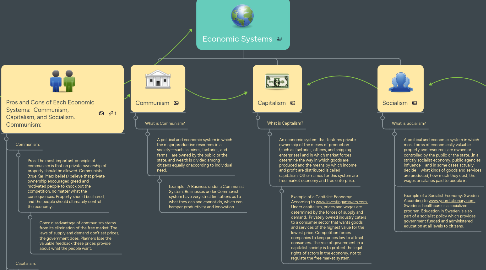
1. Capitalism
1.1. What is Capitalism?
1.1.1. An economic system that features private ownership of the means of production (such as factories, offices, and shipping enterprises) and in which market forces determine the way in which goods are produced and the means by which income and profit are distributed is called capitalism. Other names for this system are free market economy and free enterprise.
1.1.1.1. Example of a Capitalist Economy: According to www.investinganswers.com, Under capitalism, prices and wages are determined by the forces of supply and demand. Privately owned industry caters to a consumer sector that wants goods and services of the highest value for the lowest price. Competition forces companies to keep prices low to attract consumers. The role of government in a capitalist society is to protect the legal rights of actors in the economy, not to regulate the free market system.
2. Socialism
2.1. What is Socialism?
2.1.1. A political and economic system in which most forms of economically valuable property and resources are owned or controlled by the public or the state. .In a strictly socialist economy, public agencies influence—and in some cases actually decide—what kinds of goods and services are produced, how much they cost, the wages or salaries paid to people in.
2.1.2. Example of a Socialist Economy: Sweden According to www.yourdictionary.com, Sweden's healthcare is a socialized program. Education in Sweden is also part of a socialist policy which provides government funded and administered education at all levels to citizens.
3. Communism
3.1. What is Communism?
3.1.1. A political and economic system in which the major productive resources in a society—such as mines, factories, and farms—are owned by the public or the state, and wealth is divided among citizens equally or according to individual need.
3.1.1.1. Example: A Business under a Communist System: Businesses under Communist system have very strict limitations as to what they can and cannot do, which can hamper productivity and innovation.
4. Pros and Cons of Each Economic Systems: Communism, Capitalism, and Socialism. Communism:
4.1. Communism:
4.1.1. Pros: The most important principle of communism is that no private ownership of property should be allowed. Communists (true Karl Marx beliefs) believe that private ownership encouraged greed and motivated people to knock out the competition, no matter what the consequences. Property should be shared, and the people should ultimately control the economy.:
4.1.1.1. Cons: disadvantage of communism stems from its elimination of the free market. The laws of supply and demand don't set prices, the government does. Planners lose the valuable feedback these prices provide about what the people want.
4.2. Capitalism:
4.2.1. Pros: Economic freedom helps political freedom. If governments own the means of production and set prices, it invariably leads to a powerful state and creates a large bureaucracy which may extend into other areas of life.
4.2.1.1. Cons: Monopoly power. Private ownership of capital enables firms to gain monopoly power in product and labor markets. Firms with monopoly power can exploit their position to charge higher prices.
4.3. Socialism:
4.3.1. Pros: The system eliminates poverty. It provides equal access to health care and education. No one is discriminated against. Everyone works at what one is best at and what one enjoys
4.3.1.1. Cons: The biggest disadvantage of socialism is that it relies on the cooperative nature of humans to work. It ignores those within society who are competitive, not cooperative. Competitive people tend to seek ways to overthrow and disrupt society for their own gain.
5. United States, a Mixed Economy?
5.1. The economic system of the United States is principally one of private ownership. This system, often referred to as a "free enterprise system," can be contrasted with a socialist economic system, which depends heavily on government planning and public ownership of the means of production.
5.1.1. What makes it also a Social Economic System: Government, at the federal, state and local levels, seeks to promote the public safety, assure reasonable competition, and provide a range of services believed to be better performed by public rather than private enterprise. Some of these public services include the administration of justice, education (although there are many private schools and training centers), the postal (but not the telephone) service, the road system, social statistical reporting and, of course, national defense.
6. Why Economic Systems are important?
6.1. Economic systems are the means by which countries and governments distribute resources and trade goods and services. They are used to control the five factors of production, including: labor, capital, entrepreneurs, physical resources and information resources.
6.1.1. Without a system, how would an economy exist? A society’s economic system determines how the society answers its fundamental economic questions of, again, what to produce, how the output is to be produced, who is to get this output, and how future growth will be facilitated, if at all.
